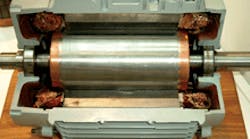Authored by: Key points: Resources: Copper Development Association, www.copper.org FAVI S. A., www.favi.com/ang/accueil.php?msg=rotorac SEW-Eurodrive, GmbH, www.seweurodrive.com Siemens Energy & Automation Inc., motor site, www2.sea.siemens.com/Products/Electric-Motors/ |
Today the NEMA Premium rating is the highest motor efficiency standard in the world. Spelled out in the Energy Independence and Security Act of 2007, it boosts mandated efficiency levels for motors covered under older legislation and applies standards to seven additional motor types.
The stringent levels spelled out in NEMA Premium tables have fostered a lot of interest in motor architectures that can deliver high efficiency. One of those architectures uses a rotor cast from copper. Today three motor makers, FAVI S.A. in France, SEW Eurodrive GmbH, and Siemens Energy and Automation Inc., all make copper-rotor designs. FAVI doesn’t sell in the U.S., but SEW and Siemens copper models first came on the U.S. market about three years ago.
The motivation for a copper-rotor design stems not only from efficiency considerations but also from a desire to minimize the size of the motor. “When you make a motor more efficient, it typically gets longer,” says Siemens Marketing Manager John Caroff. “We wanted to keep the footprint as close as possible to EPAct (Energy Policy Act of 2005) motors. Our technical group decided copper rotors would be a good way to accomplish this goal. Copper cuts down on the I2R losses though it is more costly and increases the weight of the rotor a bit.”
But all motor makers had to grapple with the fact that the losses, but also because the design eliminates cooling fins on the end of the motor as part of the short-circuit ring, so there are no windage losses. We further reduce windage losses because we don’t add balancing weights. We balance the rotor by grinding off some of the material.”
Copper rotors are somewhat heavier than aluminum versions so there is more inertia to overcome as the motor starts. That means acceleration times are slightly longer. Nevertheless, says Caroff, “In the 1 to 20-hp range that the copper-rotor design handles, the difference in acceleration times is insignificant for the types of loads these motors typically handle.”
Siemens copper-rotor motors generally go into severe-duty applications found in paper processing, petrochemical plants, and refineries. “A lot of air-handling machinery will also use these motors because of their lighter frame. That lets them employ a fan structure that is not quite as beefy,” Caroff says.
SEW Eurodrive first offered copper-rotor motors in the 1 to 30-hp range about three years ago. These were high-efficiency-class devices typically applied in conveying and food and beverage production, says SEW Eurodrive Head of Motor Development Martin Doppelbauer. SEW will later this year release another copper-rotor line for NEMA Premium applications.
SEW’s approach in its earlier line was to directly substitute copper for aluminum in the rotor bars. The line to be introduced this fall will redesign the rotor and stator geometries, and it will use a different material for laminations.
SEW offers both aluminum and copper-rotor motors. “Our basic idea is to only deploy copper rotors where doing so lets you use a smaller frame size,” says Doppelbauer. “So if you want more power, instead of going to a larger frame size you can use a copper-rotor version and keep the frame size the same. Because the copper-rotor version has lower losses, its use lets you either increase the efficiency and keep the output power the same, or work with the same amount of efficiency but increase your output power.”
Doppelbauer also says it pays to be choosy about where to apply copper-rotor technology. “We’ve found it doesn’t pay to use copper rotors in every model. If you have a small frame length you are better off with aluminum. But when the rotor gets larger and larger, copper will help you keep the size down,” he explains.
And there are a few misconceptions about the inertia of copper rotors, he says. “We are always encountering the idea that copper rotors have a higher inertia because they are heavier than aluminum. It is correct that copper weighs more than aluminum, but you can make the copper rotor smaller,” says Doppelbauer. “You need to compare the smaller copper rotor to the larger aluminum version. Then you’ll see the inertia is the same. For high-efficiency motors, copper and aluminum motors behave the same, it’s just that the copper version is smaller.”
About the Author
Leland Teschler
Lee Teschler served as Editor-in-Chief of Machine Design until 2014. He holds a B.S. Engineering from the University of Michigan; a B.S. Electrical Engineering from the University of Michigan; and an MBA from Cleveland State University. Prior to joining Penton, Lee worked as a Communications design engineer for the U.S. Government.
